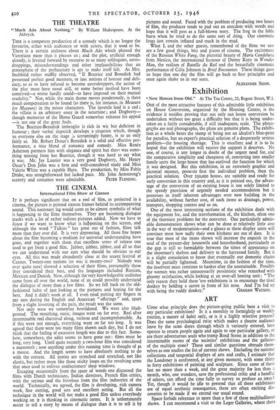THE CINEMA
International Film Show at Cannes IT is perhaps significant that on a reel of film, as projected in a cinema, the picture is printed sixteen frames behind its accompanying sound. This necessary lag would seem to be almost symbolic of what is happening to the films themselves. They are becoming dialogue tracks with a lot of rather tedious pictures added. Now we have to listen if we want to know what is happening on the screen, and although the word " Talkies " has gone out of fashion, films talk more than they ever did. It is very depressing. All those fine hopes about the film becoming a medium for universal understanding have gone, and together with them that excellent sense of release one used to get from a good film. Jabber, jabber, jabber, and all so that we can understand with our ears what should be obvious to our eyes. All this was made abundantly clear at the recent festival at Cannes. Twenty-one nations (or was it twenty-two? Nobody was ever quite sure) showed a selection of their films, presumably those they considered their best, and the languages included Russian, Mexican and Danish. Now, although the very knowledgeable audience came from all over the world, none of xis could possibly understand the dialogue of more than a few films. So we fell back on the old- fashioned habit of just looking at the pictures and hoping for the best. And it didn't work at all. I even tried putting my fingers in my ears during the English and American " offerings " and, apart from a slight lessening of the pain, the result was the same.
Not only were we somewhat bewildered. We were also blud- geoned. The mouthing, static, images went on for ever. Reel after interminable reel chattered along, verbose and incomprehensible. As if this were not enough, everything went on far too long. It was agreed that there were too many films shown each day, but I do not think that the feeling of excessive length was due to this fact. Some- how, somewhere, the edict seems to have gone out : films must be long, very long. Until quite recently a two-hour film was considered a mammoth • now anything under this running time is thought of as a mouse. And the length seems to have absolutely nothing to do with the content. All stories are stretched and stretched, not like elastic, but rather more like those sticky loops on the revolving arms that once used to enliven confectioners' shop windows.
Escaping occasionally from the spate of words one discussed the films with Dutch technicians, Indian directors, French film critics, with the serious and the frivolous from the film industries of the world. Technically, we agreed, the film is developing, rich camera work, fine cutting, good sets and excellent acting. But all the technique in the world will not make a good film unless everybody working on it is thinking in cinematic terms. It is unfortunately easier to tell a story by means of dialogue than it is to tell it by pictures and sound. Faced with the problem of producing two hours of film, the producer tends to pad out an anecdote with words and hope that it will pass as a full-blown story. The frog in the fable burst when he tried to do the same sort of thing. Our cinematic frogs just remain inflated and stuck in the mud.
What I, and the other guests, remembered of the films we saw are a few good things, bits and pieces of cinema. The excitement of the Russian White Fang, the pictorial beauty of Maria Candelaria from Mexico, the international humour of Danny Kaye in Wonder Man, the realism of Bataille du Rail and the beautifully cinematic performance of Celia Johnson in Brief Encounter. These things gave us hope that one day the film will go back to first principles and once again shake us in our seats.
ALEXANDER SHAW.






























 Previous page
Previous page